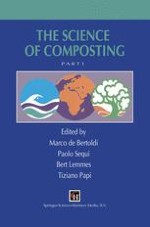1996 | OriginalPaper | Chapter
Formation and properties of humic substance originating from composts
Authors : Yona Chen, Benny Chefetz, Yitzhak Hadar
Published in: The Science of Composting
Publisher: Springer Netherlands
Included in: Professional Book Archive
Activate our intelligent search to find suitable subject content or patents.
Select sections of text to find matching patents with Artificial Intelligence. powered by
Select sections of text to find additional relevant content using AI-assisted search. powered by
Composting enables a detailed evaluation of the humification process of various organic wastes within a short period of time (3 to 6 months). Humic substances (HS) constitute a large fraction of the organic matter (OM) in compost, and they are its most active fraction due to their effects on soil ecology, structure, fertility and metal complexes, and plant growth. The formation and properties of HS extracted from various composts such as municipal solid waste (MSW), grape marc (GM), composted separated cattle manure (CSM), sewage sludge (SS), wood compost (WC) and other organic wastes were studied. Degradative and non-degradative techniques (FTIR, DRIFT, 13C-NMR) were used to study the transformation of HS during composting of the various organic wastes. Time-course studies of composting some of these wastes showed an increase in the relative amount of humic acid (HA) (from 18% to 45% of OM in CSM compost and from 5% to 20% in MSW compost), whereas the formation rate of fulvic acid (FA) was inconsistent. A humification ratio (HR – the ratio of HA/FA) was used to evaluate compost maturity. Values of 0.9 to 3.4 and 3.0 to 9.2 were typical for immature and mature composts, respectively. Another humification index (HI) used to define compost maturity was calculated as the ratio between non-humified fraction (NHF) and the humified fraction (HA+FA). A HI decrease during composting represents the formation of HS. Elemental- and functional-group analyses indicated only minor differences between HA extracted from composts at various stages. Moreover, these values fell into a wide range, similar to that of soil HA. The 13C-NMR spectra of the HA exhibited strong bands representing aliphatic structures in various composts (50% of total C in CSM, 30% in MSW and 61% in GM) and a lower level of aromatic components (37% in CSM, 22% in MSW and 22% in GM). The FTIR spectra showed similar trends of strong aliphatic and carbohydrate components. Both techniques provided more qualitative information indicating that HA extracted from mature compost exhibits more aromatic structures and carboxyl groups and less carbohydrate components than that from immature compost.Studies on the effects of HS on plant growth showed stimulative effects. Typical response curves indicated enhanced growth with increasing HS concentration in solution, followed by decreases in growth at higher concentrations. In soils, the addition of composts was found to stimulate growth beyond that provided by mineral nutrients, presumably because of the effects of HS.
